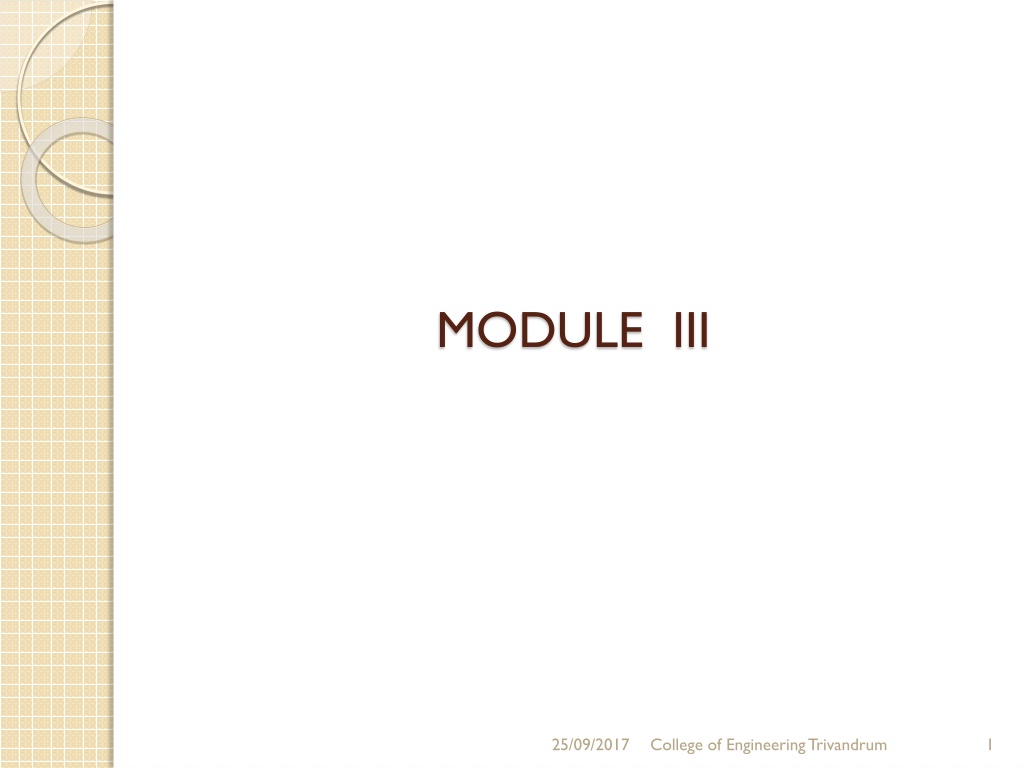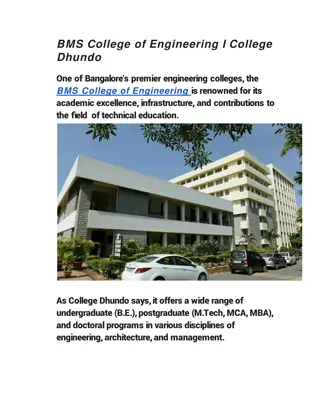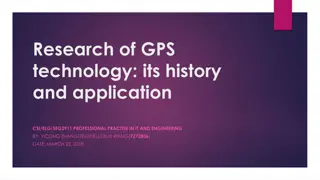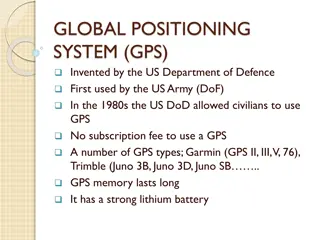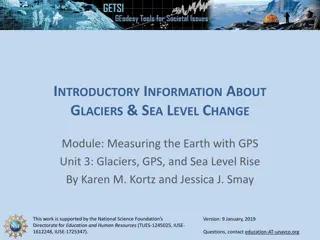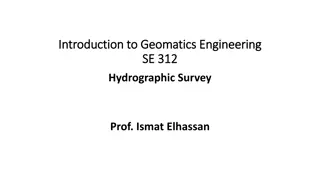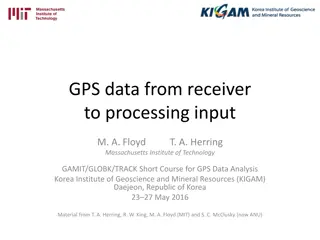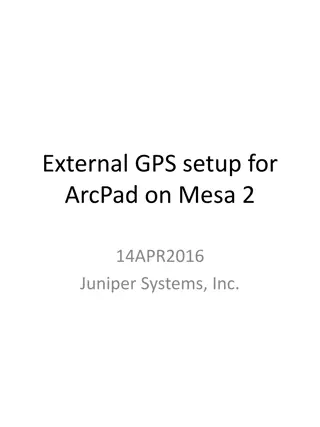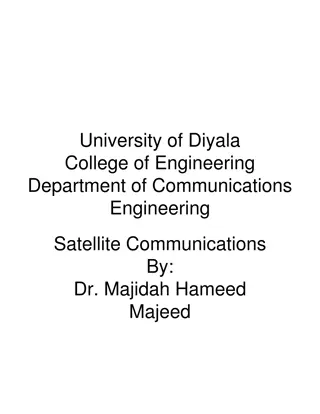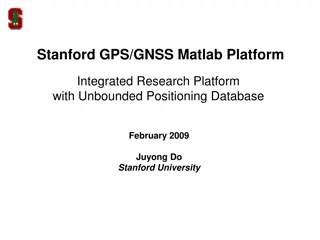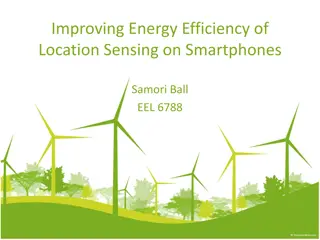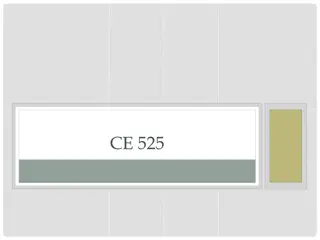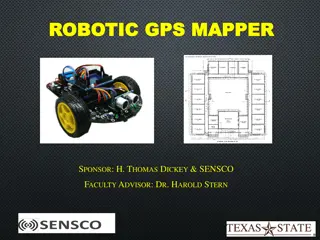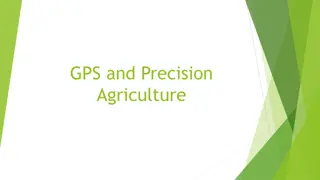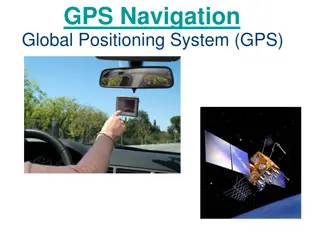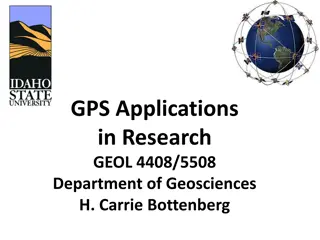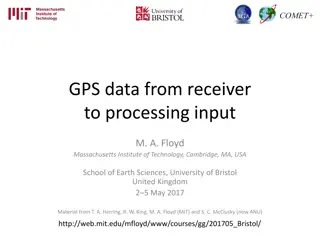Understanding Geomatics and GPS Technology at College of Engineering Trivandrum
Geomatics is the discipline of gathering, storing, and processing geographic information using tools like GPS and GIS. GPS, a satellite-based navigation system, provides accurate positioning globally. Various global navigation systems like NAVSTAR GPS by USA and GLONASS by Russia play crucial roles in navigation and positioning technologies.
Download Presentation

Please find below an Image/Link to download the presentation.
The content on the website is provided AS IS for your information and personal use only. It may not be sold, licensed, or shared on other websites without obtaining consent from the author. Download presentation by click this link. If you encounter any issues during the download, it is possible that the publisher has removed the file from their server.
E N D
Presentation Transcript
MODULE III 25/09/2017 College of Engineering Trivandrum 1
GEOMATICS Geomatics, also known as geospatial science is the discipline of gathering, storing, processing, and delivering geographic information or spatially referenced information. "Geo" refers to the land and "matics" refers to the mathematics and science used to study the land Utilize advanced tools such as Total stations, Global Positioning System (GPS), Digital aerial imagery Geographic Information Systems (GIS) Enable to gather, process, analyze, visualize and manage spatially related information to solve a wide range of technical and societal problems. 25/09/2017 College of Engineering Trivandrum 2
GLOBAL NAVIGATION SATELITE SYSTEM(GNSS) Satellite navigation uses satellites to provide geo-spatial positioning System - Satellite navigation system with global coverage may be termed a global navigation satellite system (GNSS) Allows small electronic receivers to determine their location (longitude, latitude, and altitude/elevation) 25/09/2017 College of Engineering Trivandrum 4
Various global navigation systems NAVSTAR GPS by USA GLONASS by Russia Galileo by European Union IRNSS (Indian Regional Navigation Satellite System, NavIC) GAGAN (GPS Aided Geo Augmented Navigation) 25/09/2017 College of Engineering Trivandrum 5
GLOBAL POSITIONING SYSTEM (GPS) Satellite-based radio navigation system High precise positioning system Developed by US dept of Defence Shortened form of NAVSTAR GPS NAVigation System with Time And Ranging Global Positioning System Uses constellation of 24 operational satellites, to give user an accurate position on earth 25/09/2017 College of Engineering Trivandrum 6
GLOBAL POSITIONING SYSTEM (GPS) (Contd.) Originally designed for military purpose Later used for marine navigation and surveying Finding positional values accurately at any point on earth s surface, at any time and in all weather conditions 25/09/2017 College of Engineering Trivandrum 7
SYSTEM OVERVIEW OF GPS Space segment Satellites orbiting the earth Control segment Control stations positioned at various locations to control the satellites User segment GPS users Anybody who receives and uses the GPS signal comes under this segment 25/09/2017 College of Engineering Trivandrum 8
SYSTEM OVERVIEW OF GPS (Contd..) 25/09/2017 College of Engineering Trivandrum 9
THE SPACE SEGMENT Constellation of GPS satellites and the signals broadcast by them Allows users to determine position, velocity and time 24 satellites at an altitude of 20,200 km orbiting the earth every 12 hours Travelling at speeds of 11,500 km per hour Powered by solar energy (back up batteries are also there) Satellites in six orbital planes 25/09/2017 College of Engineering Trivandrum 10
FUNCTIONS OF SATELLITES The functions of satellites are: To receive and store data transmitted by the ground control stations To maintain accurate time by means of several on-board atomic clocks To transmit information and radio signals to users 25/09/2017 College of Engineering Trivandrum 11
CONTROL SEGMENT Consists of: One master control station Four monitoring stations Four ground antennas Master station in Colorado Springs, Colorado (USA) Four monitoring stations at Cape Canaveral, Ascension Island, Diego Garcia and Kwajalein Atoll 25/09/2017 College of Engineering Trivandrum 12
CONTROL SEGMENT (Contd..) 25/09/2017 College of Engineering Trivandrum 13
CONTROL SEGMENT (Contd..) Tracks GPS satellites, update their orbiting position and calibrates and synchronizes their clocks To determine the orbit of each satellite and predict its path for the next 24 hours There may be possibility of satellites travelling out of orbits Ground monitor stations keep track of satellite orbits, altitude, location and speed Ground stations send the orbital data to master control stations, which send corrected data to the satellites through ground antennas Corrected and exact position of data is called Ephemeris 25/09/2017 College of Engineering Trivandrum 14
THE USER SEGMENT Comprises GPS receivers used to receive the GPS signal for determination of position and time The typical receiver is composed of an antenna and preamplifier, radio signal microprocessor, control and display device, data recording unit, and power supply. GPS receivers convert signals into position, velocity, and time estimates. A minimum of four satellites are required to compute the four dimensions of X, Y, Z (position) and Time. Typical applications within the user segment are land navigation, marine navigation, surveying and aerial navigation 25/09/2017 College of Engineering Trivandrum 15
WORKING OF GPS All the 24 satellites are constantly revolving around the earth in a very definite orbit The satellites from their orbits transmit information to earth The GPS receiver on the Earth receives this signal and with the help of triangulation of signals from other satellites, it can determine the geographic location. It does this using accurate time measurements. The clock that the satellites maintain are very accurate atomic clocks GPS receiver correlates the time between which a signal was broadcasted by the satellite with the time it was received. This difference in time tells the GPS receiver about one aspect of your location, and by connecting with some more of the 24 revolving satellites around Earth you can accurately obtain your latitude, longitude, altitude, speed and bearing. 25/09/2017 College of Engineering Trivandrum 17
ADVANTAGES Relatively high positioning accuracies, in mm level Capability of determining velocity and time Signal availability to users, anywhere on the globe Positioning system with no user charges and uses relatively low cost hardware All weather system, available 24hrs a day Position information is in 3 dimensions 25/09/2017 College of Engineering Trivandrum 18
FEATURES OF GPS A one-way ranging system, in which the satellites transmits signals, but are unaware of who is using the signal. Hence the user cannot be Detected by enemy (military context) Charged for using the system (civilian context) Use of latest atomic clock and microwave transmission technology, including spread-spectrum techniques Satellite signals are unaffected by cloud and rain 25/09/2017 College of Engineering Trivandrum 19
FEATURES OF GPS (Contd..) Multiple satellite system, which ensures the visibility of sufficient number of satellites anywhere on the globe, at any time not less than four satellites at any time, at any point on the surface of earth 25/09/2017 College of Engineering Trivandrum 20
SIGNAL The transmitter power of a Global Positioning System satellite is a 50 watts. The satellite transmits two carrier waves (radio waves), L1 and L2, derived from the fundamental frequency of 10.23 MHz, generated by atomic clock L1 carrier is broadcast at 1575.42 MHz (10.23X154) L2 carrier is broadcast at 1227.60 MHz (10.23X120) 25/09/2017 College of Engineering Trivandrum 21
SIGNAL (Contd.) L1 carrier has two codes modulated upon it Coarse/Acquisition code (C/A Code) 1.023MHz Precision code (P-Code) 10.23 MHz L2 carrier has one code modulated upon it Precision code (P-Code) 10.23 MHz 25/09/2017 College of Engineering Trivandrum 22
SIGNAL (Contd.) The signals can penetrate through plants, clouds, glass but will not go through solid structures and mountains Each signal consists of three different bits of information a pseudorandom code, ephemeris data and almanac data. The pseudorandom code is simply an I.D code which identifies which one of the 24 GPS Satellites this signal is coming from. Ephemeris data is the heart of the signal. This part of the information is essential for determining position. It contains data about the status of the satellite, current date and time The almanac data instructs the GPS Receiver about the orbital information of all the 24 satellites; basically this tells the Global Positioning System where all the satellites are and will be. 25/09/2017 College of Engineering Trivandrum 23
GPS CODES GPS codes are binary, strings of zeros and ones, the language of computers Coarse/Acquisition code (C/A Code) 1.023MHz Precision code (P-Code) 10.23 MHz Transmitted code is called pseudo- random code Since it looks like a noise signal Complex code Each satellite has its own unique pseudo-random code 25/09/2017 College of Engineering Trivandrum 24
GPS SATELLITE SIGNAL STRUCTURE 25/09/2017 College of Engineering Trivandrum 25
GPS SATELLITE SIGNAL STRUCTURE (Contd..) 25/09/2017 College of Engineering Trivandrum 26
SATELLITE RANGING Satellite range distance from the satellite to the GPS receiver GPS positions are based on the distance from the satellite to the GPS receiver on earth Basic idea of determination of position is resection or trilateration Distance = velocity X time Velocity of radio signal = 290,000 km per s (almost equal to speed of light) Precise time - when signal left the satellite and when it reach the receiver 25/09/2017 College of Engineering Trivandrum 27
SATELLITE RANGING - TIME CALCULATION Main purpose of coded signal is: calculation of travel time of radio signal from satellite to GPS receiver Also called Time of Arrival When pseudo-random code reaches GPS receiver, it generates the same code and tries to match with the satellite s code Receiver compares two codes to determine how much delay is required in its code to match the satellite code 25/09/2017 College of Engineering Trivandrum 28
SATELLITE RANGING - POSITION CALCULATION Four unknowns to be determined Position coordinates (x,y,z) Time of travel of signal Observation of four satellites produces four equations When receiver picks up a signal from one satellite, the position will be an imaginary sphere with satellite as centre and distance as radius GPS receiver starts picking up signals from two satellites 25/09/2017 College of Engineering Trivandrum 29
SATELLITE RANGING - POSITION CALCULATION (Contd..) 25/09/2017 College of Engineering Trivandrum 30
SATELLITE RANGING - POSITION CALCULATION (Contd..) Position of GPS receiver will be along the intersection of two large circles When receiver picks up signals from third satellite, the position of receiver will be on the point of intersection of three circles With four satellites, the receiver will get a precise position and it will be able to compute the elevation of position with reference to a selected datum 25/09/2017 College of Engineering Trivandrum 31
GPS MEASUREMENT TECHNIQUES 2 types of signal measurement approaches have been used for positioning with GPS Important observables are code and phase values methods based on these two are used Code measurements Carrier phase measurements 25/09/2017 College of Engineering Trivandrum 32
CARRIER PHASE MEASUREMNT Processing technique that gathers data via a carrier phase receiver, which uses the radio signal (carrier signal) to calculate positions. The carrier signal, which has a much higher frequency than the pseudo-random code, is more accurate than using the pseudo-random code alone. GPS receivers which record carrier phase, measure the fraction of one wavelength (i.e. fraction of 19 cm for the L1 carrier) when the receiver first locks onto a satellite and continuously measure the carrier phase from that time Number of cycles between the satellite and receiver at initial start up (known as the ambiguity ) and the measured carrier phase together represent the satellite-receiver range 25/09/2017 College of Engineering Trivandrum 33
CODE PHASE MEASUREMENT Processing technique that gathers data via a C/A (coarse acquisition) code receiver, which uses the information contained in the satellite signals (the pseudo-random code) to calculate positions. A GPS receiver determines the travel time of a signal from a satellite by comparing the "pseudo random code" it's generating, with an identical code in the signal from the satellite The receiver "slides" its code later and later in time until it syncs up with the satellite's code Amount it has to slide the code is equal to the signal's travel time Code measurements are the difference in time between when the code is transmitted from a satellite and received at a GPS receiver, multiplied by the speed of light 25/09/2017 College of Engineering Trivandrum 34
Carrier phase vs code phase The carrier phase receivers are much more accurate than C/A code receivers Carrier phase receivers require a clear view to the satellites in order to maintain a constant lock with at least 4 satellites, while C/A code receivers do not need to maintain a constant lock with the satellites to calculate positions. This makes a C/A code receiver imperative to gathering data in adverse conditions Code phase processing- GPS measurements based on the pseudo random code (C/A or P) as opposed to the carrier of that code. (1-5 meter accuracy) Carrier phase processing- GPS measurements based on the L1 or L2 carrier signal. (sub-meter accuracy) 25/09/2017 College of Engineering Trivandrum 35
GPS ERRORS Ephemeris errors Clock stability Ionospheric delays Tropospheric delays Multi-path Dilution of Precision Satellite and receiver clock errors Antispoofing Receiver noise 25/09/2017 College of Engineering Trivandrum 36
1. EPHEMERIS ERRORS Errors in the prediction of a satellite position Satellite dependent Very difficult to correct 25/09/2017 College of Engineering Trivandrum 37
2. CLOCK STABILITY GPS satellites carry rubidium and cesium time standards Receivers are accurate by Quartz standard accuracy Time offset difference between time recorded by satellite clock and that recorded by receiver RE = T0 X c where, RE = User Equivalent Range Error (UERE) T0 = time offset c= speed of light 25/09/2017 College of Engineering Trivandrum 38
3. IONOSPHERIC DELAYS Non-linearly dispersed and refracted when transmitted through a highly charged environment like ionosphere Results in an error in the GPS range value Ionospheric range effect dispersion and refraction of GPS signal Signal is slowed down since the medium is denser Factors that influence the amount of delay Satellite elevation and geometry Density of ionosphere 25/09/2017 College of Engineering Trivandrum 39
25/09/2017 College of Engineering Trivandrum 40
4. TROPOSPHERIC DELAYS GPS signals are refracted while in troposphere Density of troposphere governs the severity of its effect 25/09/2017 College of Engineering Trivandrum 41
5. SIGNAL MULTIPATH Occurs when the signal arrives at the receiver from more than one path Occurs when the GPS receiver is positioned close to a large reflecting surface such as big rock or a building Signal hits the object and is reflected to receiver creating a false measurement Increase the travel time of signal 25/09/2017 College of Engineering Trivandrum 42
25/09/2017 College of Engineering Trivandrum 43
6. GEOMETRIC DILUTION OF PRECISION (GDOP) Measure of strength of satellite geometry Wider the angle between satellites, the better the measurement A low DOP indicates a higher accuracy, and a high DOP indicates a lower accuracy. Low value is good (less than 8) Best to observe satellite 15 above the horizon 25/09/2017 College of Engineering Trivandrum 44
GDOP 25/09/2017 College of Engineering Trivandrum 45
7. SATELLITE AND RECEIVER CLOCK ERRORS Satellite clocks are very accurate to about 3 nanoseconds Sometimes drift slightly and cause small errors US department of Defence monitors the satellite clocks using the control segment and corrects the drift 25/09/2017 College of Engineering Trivandrum 46
8. ANTI-SPOOFING (A/S) Intended to deny the P-code part of GPS signal Forcing the user to use C/A code, which has A/S applied Encrypts the P-code into a signal called the Y-code Only users with military GPS receivers can decrypt the Y-code 25/09/2017 College of Engineering Trivandrum 47
25/09/2017 College of Engineering Trivandrum 48
9. RECEIVER NOISE Includes a variety of errors associated with the ability of the GPS receiver to measure a finite time difference Include signal processing, clock/signal synchronization and correlation methods, receiver resolution, signal to noise ratio etc 25/09/2017 College of Engineering Trivandrum 49
APPLICATION OF GPS Used for navigation by mariners and fishermen Survey operations Emergency road side assistance at the push of a button Vehicle tracking Route guidance 25/09/2017 College of Engineering Trivandrum 50
